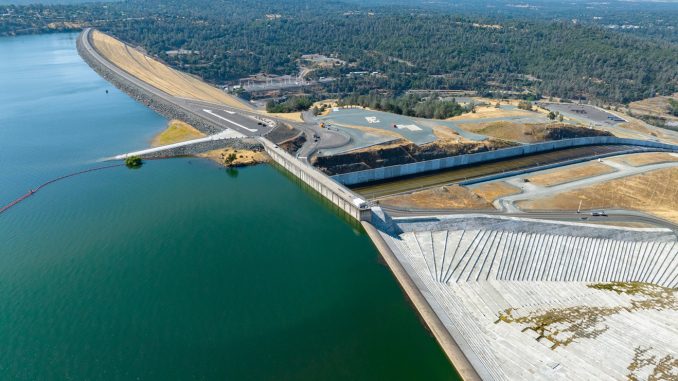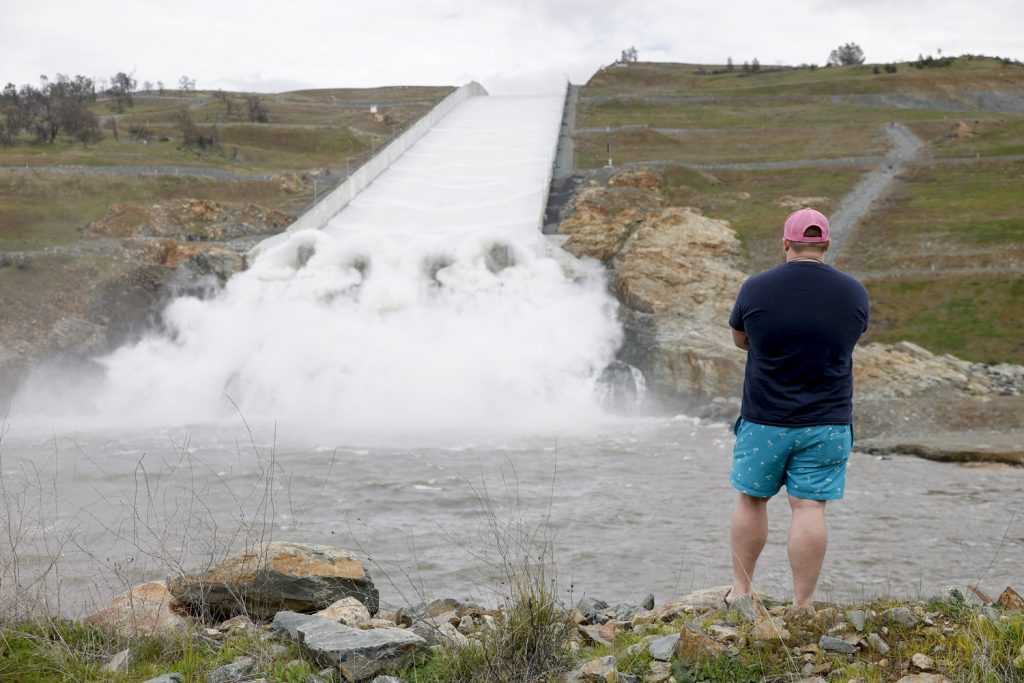
By Rachel Becker (for Cal Matters)
CalMatters is an independent public journalism venture covering California state politics and government. For more info, visit calmatters.org.
As forecasts tease California with rainstorms in early December, the state’s reservoirs are already flush with water.
It’s a big departure from a year ago: The state’s major reservoirs—which store water collected mostly from rivers in the northern portion of the state—are in good shape, with levels at 123 percent of average (as of Nov. 27). In late 2022, bathtub rings of dry earth lined lakes that had collectively dipped to about two-thirds of average—until heavy winter storms in January filled many of them almost to the brim.
Yet healthy water levels don’t mean California’s reservoirs are full. Most of California’s large reservoirs are operated for flood control as well as water storage, with space kept empty to rein in winter storm runoff.
The wet season has arrived in California, with El Niño conditions projected to continue strengthening. But for the Golden State, with its unpredictable swings from dry to wet and back again, El Niño doesn’t guarantee heavy rainfall.
And as California’s water managers plan for the water year ahead, they’re faced, as always, with their dueling responsibilities: forestalling floods while preparing for possible scarcity in a state where water supplies are often stretched thin and long droughts are common.
When state climatologist Michael Anderson looks into California’s water year ahead, he says the crystal ball is cloudy.
A murky forecast, both near and far
After an unpredictable and mostly dry November—which saw heavy precipitation for some parts of the state in the week leading up to Thanksgiving—“things are lining up for the pattern to become progressively more active and wetter in California starting around early to mid-December,” according to predictions from the Weather West climate analysis website.
Some headlines heralded last month’s rains as the first storms of many as El Niño continues to strengthen and intensify. Characterized by warming of the central and eastern tropical Pacific Ocean, El Niño is often expected to bring wetter weather.
But in California, the connection is more tenuous. Of seven El Niño events over the past 23 years, Anderson said, two have been dry, three have been roughly average and two have been wet. One recent study reported that El Niño accounts for only about 25 precent of the year-to-year variability in California’s rain and snowfall during the winter.
“What that tells me is anything goes,” Anderson said. “El Niño by itself doesn’t define our water year.”
In fact, the year is actually off to a drier start: Statewide, California has seen only about 52 percent of average precipitation since this water year began Oct. 1.
Marty Ralph, director of the Center for Western Weather and Water Extremes at UC San Diego, suspects that it’s atmospheric rivers like the ones that pummeled California last year that will determine whether El Niño will bring a firehose or a trickle to California.
“It’s like you’re playing poker, and you’ve got a good hand—that’s El Niño for us. But we haven’t finished the round of the game, and we still have to draw a couple cards,” Ralph said. “But we might not draw the good cards.”
Waste not, want not?
With seasonal outlooks unable to reliably say whether a winter will be wet or dry, water managers must plan for both.
Fortunately there’s some wiggle room this year, according to Jeanine Jones, the Department of Water Resources’ interstate resources manager. Last year’s massive snowpack and abundant rainfall filled the state’s reservoirs enough that even if this rainy season leans dry, she said, “We’re going into next year with a cushion, which is always good.”

That doesn’t mean the reservoirs are full, though. Lake Oroville—the largest reservoir on the State Water Project, which sends water south to farms and cities—and Lake Shasta—critical to growers and other water users reliant on the federal Central Valley Project—are at about two-thirds of their total capacity.
That’s because with reservoirs that serve the dual purpose of flood control and water storage, water managers must release water to keep space empty to wrangle possible floods during the wet season, Jones said.
The water that flows into rivers and streams and out to the ocean is often bemoaned as water wasted. But waste is in the eye of the beholder, said Jay Lund, vice-director of the Center for Watershed Sciences at UC Davis.
“Water that’s ‘wasted’ is always water used by somebody else,” Lund said.
The list of benefits for fishing, conservation, Delta farmers, water quality and healthy shorelines is lengthy. Water allowed to flow out into the San Francisco Bay, for instance, washes away salts and pollutants, transports sediment and sand necessary to maintain marshes and restore eroding beaches, assists salmon in migrations and helps maintain healthy ecosystems.
Still, the Public Policy Institute of California reports that California could have socked away more water last year, had there been better ways to ferry water from full rivers to groundwater recharge sites, and better coordination among landowners, local agencies, and others.
“I tend to think that there is room for capturing more surface water … if you could afford the cost of capturing it,” agreed Lund. “That, to me, is the biggest problem.”
The controversial Sites Reservoir project, for instance, is projected to cost more than $4.4 billion. The reservoir, planned in the western Sacramento Valley, would store as much as 1.5 million acre-feet of Sacramento River water, alarming environmental groups that say drawing more water from the river will imperil its already-struggling fish.
In early November, Gov. Gavin Newsom cleared the project to be fast-tracked “to the extent feasible” through any litigation challenging it under the landmark California Environmental Quality Act. That move was made possible with new legislation. Even so, the project is not expected to be completed before 2030 or 2031.
In the meantime, researchers like UC San Diego’s Ralph, along with local, state and federal agencies, hope to operate the state’s reservoirs more nimbly by incorporating new weather forecasting tools into decades-old rulebooks governing when to hold onto water and when to release it.
The program allowed the Russian River watershed to hold onto about 7,000 to 8,000 acre-feet more water in Lake Mendocino this past year, and an additional 19,000 acre-feet more in Lake Sonoma, according to Donald Seymour, deputy director of engineering with Sonoma Water. The Department of Water Resources announced that it is expanding the effort to two major reservoirs, Lake Oroville and New Bullards Bar, as well.
Many are looking down rather than up for opportunities to store more water. The Department of Water Resources estimates that about 3.8 million acre-feet of water was captured through groundwater recharge by last summer.
The Southern California water import giant, the Metropolitan Water District, also recently announced a $211 million groundwater bank in the Antelope Valley. The bank can store 280,000 acre-feet of water, enough to fill Castaic Lake, the largest State Water Project reservoir in Southern California. Though construction to allow withdrawals hasn’t been completed yet, the bank stands ready to accept deposits.
The bank is aimed at providing a little more net for the tightrope walk that California’s water managers start anew every water year.
“We always plan for it to be potentially very dry, or very wet,” said Brad Coffey, Metropolitan’s water resources manager. “No matter what kind of year we had this year.”
Note: The CN&R adjusted some rainfall numbers and weather details in this story to reflect forecasts and totals that were current as of print deadline.




Be the first to comment